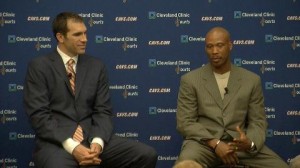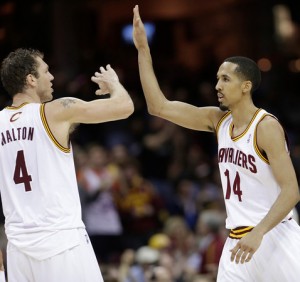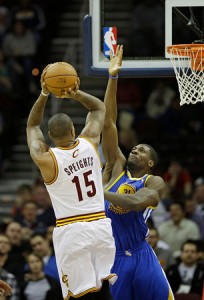Lessons from the Bench
2013-03-29The Cavs core contains: Kyrie Irving – Dion Waiters – Tristan Thompson – Tyler Zeller
All four members of the core were selected with first round picks in the last two drafts. It’s reasonable to assume that at least 1 more draft pick will be added to the core this offseason. The core remains solidified barring a major trade until at least 2015.
The Cavs bench can reasonably include: Shaun Livingston – Wayne Ellington – Luke Walton – Marreese Speights
The bench contains waiver-wire gem Shaun Livingston and 3 guys acquired in salary dumps. It’s easy to imagine the trades were more about the accompanying draft picks than anything else. But then they started playing together, and the Cavs, perhaps buoyed by a less grueling schedule, suddenly looked like a decent team. The fate of the bench, or the Herculoids as they’re known around here, is anybody’s guess. Logic suggests Ellington will be back, and I think Speights will opt-out, making it highly unlikely he returns to the Cavs. Walton and Livingston will be unrestricted free agents. [HoopsWorld]
The core and the bench share a locker room, and not much else. Consider some of the differences:
Age and Experience: Zeller is the adult of the core, and the other 3 could still be in college next season had they stayed. Ellington and Speights are 3 and 4 year players and Livingston and Walton are certified veterans.
Offensive Approach: The core scores more than 20% of its points off turnovers, and scores almost 11% of its points in transition. The bench generates about 15% of its points off turnovers, but only 6% in transition. The core has the edge in points in the paint and plays at a faster pace. Naturally, it is a more athletic ensemble and tries to leverage that athleticism on offense. Armed with only that information, you might suppose the core is a more efficient offensive team. But it’s the opposite. The core has posted an offensive rating of 100.9, while the bench sits comfortably at 107.7. For perspective, the Heat lead the NBA with an ORTG of 112.6 and the Wizards are last with a 99.9 mark.
Defensive Approach: The core generates a lot of turnovers. At a rate of 16.4% of opponent possessions ending in turnovers, that’s good for 5th in the NBA. Their opponent foul shot to field goal attempted ratio (FTA/FGA) is slightly better than league average so they aren’t playing Jerry Sloan defense in order to force the turnovers. The core secures only 70.4% of opponent misses – which would be the worst mark in the NBA this season. The bench generates a more modest 14.2% opponent turnover rate, sends teams to the line more often, and does a decent job blocking out offensive rebounders – securing 76.1% of missed shots (higher than any NBA team this season). The core bites more on pump fakes and chases shooters off the three point line, whereas the bench tends to concede many more triple tries over cemented feet and outstretched arms. The core gives up 7 threes a game at 43% while the bench gives up 9 threes a game at 37%. The core really can’t stop anybody on defense and is often exposed on the perimeter during a pick and roll. The D breaks down and the players are left scrambling after the ball handler the way pee-wee soccer teams play defense. The bench does a slightly better job, often choosing to switch screens on the perimeter limiting the crippling bouts of 4 on 5 defense. The bench is longer, and more fundamentally sound, making life more difficult on ball handlers. The bench gives up 46% FG and 36% 3PFG which is below average, while the core gives up 50% FG and 43% 3PFG which is shockingly poor and would easily generate the worst eFG% in the NBA.
The situation may not be quite as dire as presented above. The bench as categorized avoided much of the early season gauntlet and does get the benefit of playing more minutes against opponent 2nd stringers. Still, they do many things better than the core. As the youth movement comes of age there are lessons that they can learn from their elders. I’ll highlight a few that I’ve noticed over the course of the season.
1.) Movement without the ball
Here at CtB we’ve bemoaned offensive stagnation all season – specifically when Dion and Kyrie are the culprits. Check out Kevin’s answer to question 1. https://cavstheblog.com//////////////////////////////////////////////////////////////////////////////////////////////////////////////////////////////////////////////////////////////////////////////////////////////////////////////////////////////////////////////////////////////////////////////////////////////////////////////////////////////////?p=18025 Neither player seems willing to make defenses pay any attention when the other is in isolation. The Herculoids are a great lesson in moving without the ball. Few offensive possessions feature non-ball handlers clearing out and waiting for something to happen. Ellington flashes to the corners and Livingston does a great job keeping defenses honest by constantly making sharp backdoor cuts when he doesn’t have the ball. Luke Walton’s willingness to pass is the secret ingredient that keeps the other players hungry to find an opening. Walton, Livingston, and Ellington all make better use of screens than their younger brethren and it creates a fluid offense that scores well in half-court sets. This is something the core must improve upon if they are to compete in the playoffs. Good defensive teams can make even the best isolation scorers inefficient in the half-court. Think back to the 2008 Celtics against the Cavs. The game slows down in the playoffs, defenses tighten, and offenses really need to move defenders from sideline to sideline to generate easy looks.
http://www.youtube.com/watch?v=e0NHYkG-dtM
2.) Using individual moves to gain an advantage for teammates
It’s the black mark of a chucker, really. The AI/Kobe/Melo syndrome. These players can get their shot off from anywhere on the court. Iverson did it with his elite handle, Kobe does it with elite footwork and balance, and Melo does it with a nasty jab-step jumper and explosive first step. But these guys are not natural facilitators. When they start losing games questions often arise about how well they fit with their teammates. And we all remember how Melo + AI worked out. Contrast those prolific one-on-one scoring attacks with a team like the Spurs, where small advantages are leveraged to give other players much bigger ones. The Cavs bench provides a nice example of this. Walton and Livingston are the focal points again. Both players, even with range limitations on their shot and below average athleticism, are superior to Irving and Waiters at creating seams for their teammates to score more easily. Walton, despite shooting 29% on threes and sporting a career TS% below .500 gets so many defenders to bite on his deliberate pump fakes. He uses that slight opening to take a dribble or two into the teeth and gets another defender to step up. With 2 players out of position, the court is his canvas and he regularly finds Shaun Livingston moving into the open space for layups and uncontested mid-range Js. These are skills the core really needs to hone. For all of Kyrie’s prodigenous (first used here) talents, he is weak at passing out of double teams and exploiting the 3 on 4 defense that remains. Waiters seems more willing to use his explosive first step to draw defenders and then dish off once the defense has collapsed – a welcome sign. Overall, the creativity and willingness to pass needs to manifest after the initial defensive breakdown. TT can afford to look for cutters as well when he makes his strong bull move across the lane. He’s gotten better at creative counters to give himself angles around the basket. However, when he gets pushed away from his sweet spot by a committed defense, he can survey for open perimeter shooters. The bench scores 64% of it baskets off assists, compared to the core at 56% despite less dynamic offensive players.
http://www.youtube.com/watch?v=vIwWciO_h8s#t=1m56s
3.) Decisiveness
One of the mysteries of the Cavaliers season is how a bunch of cast-offs could play so well together. It’s never easy to integrate new players to an existing system. But in this case, most variations of the Herculoids contained no more than 2 players that had ever played together. And despite that, they seem supremely comfortable executing offense. Some of this is due to the decisiveness of the personnel. Watching Kyrie and Dion in isolation can be a lot like watching a cat stalk/attack its prey. It might probe, it might play, it might pounce. It’s hard to predict. I’ve mentioned on numerous occasions how ineffective some of the picks set for Kyrie are, because he doesn’t really use them. He generally plays with his defender using elite ball-handling and one on one moves, trying to get his defender to bite before finally creating the separation he needs to score. But there’s a reason cats hunt alone. The bench guys probably learned after the first practice that Luke Walton would always look for them to cut backdoor, that Mo Speights would rise up and shoot anything he got his hands on, that Shaun Livingston loves backing down smaller guards to collapse the defense and that Wayne Ellington would always find open space to fill around the perimeter. Making crisp, decisive moves and forcing the defense to react to that is an effective way for players to get comfortable playing with each other. All season I’ve commented that the starters don’t seem to be more than the sum of their parts – sometimes even less than that. The decisiveness with which the bench approaches the offense has made it easy for strangers to develop chemistry quickly.
4.) Composure
The Cavs core has played considerably worse this season on the road. The offensive rating in road games is a putrid 98.6. It is also much worse in second halves: 98.0 versus 103.8 in the first half. The bench exhibits the opposite on both counts: playing better on the road and in second halves. Part of the reason for the Cavs offensive woes is that they don’t generate easy baskets in the half court unless individuals catch fire. When defenses ramp up the intensity, the Cavs core often folds. At the other end of the court, the pick and roll devastates the core’s perimeter defense – often on account of poor anticipation by Kyrie, and slow lateral quickness by Zeller trying to stop the penetration. The bench production seems to be less effected by place and time.
5.) Toughness
The Cavs are not a tough team, but the addition of Livingston and Speights provided examples of both a mentally tough and a physically tough player. Watching Livingston direct the defense and constantly fight until the end of so many heart-wrenching losses should motivate the young guys. That sort of leadership and attitude is something that could elevate Kyrie from all-star to generational superstar. The success of the team is going to hinge on Kyrie’s commitment. If he’s content to take plays/quarters/games off, particularly at the defensive end, so will the rest of the UncleDrew army. Waiters needs to stay mentally tough as well. He has been resilient this year, and quieted concerns about his character and coachability. But he needs to stay in attack mode even when he’s not getting the better end of whistles. I’ve come prepared to help. Zeller can learn a thing or two from Speights. Maybe not on defense where Speights has been poor, but noting instead how he throws his body around and punishes defenders under the basket. For a guy that’s a bit undersized and has a rep for chucking – he gets to the line quite a bit and has really honed his jumper – something Zeller needs to emulate. He also has a bit of a mean streak – which many of the Cavs could experiment with from time to time when situation demands it.
There are lots of opportunities for the Cavs core to assimilate some of the traits and skill sets of that bench guys that give them a breather every night. Hopefully they are taking notes.





Sloan is 71. He’s probably not coming back.
Speaking of Jerry Sloan, that’s one guy I’d definitely take over Byron Scott. Can you imagine kyrie running the modified flex? It would be ridiculous
Nice, this piece breaks down a lot of what I wish we’d see from the Cavs’ core… what about a #6) Hunger: similar to Toughness, but I mean more so that fieriness and drive to conquer the way to bloody glory (winning). I mean LeBron since seeing the Mavs raise a trophy on his home court; Kobe-thirsty. Not to say the young Cavs players don’t strive — the dudes are pro athletes, they like to compete — just that the edge is missing, that willingness to embrace accountability for all the things that happen in a game. The one who… Read more »
And it hasn’t occurred to Coach Scott that having Gee spot up in the corner is probably the worst possible use of his skillset? I’m really starting to doubt whether this team can go the distance with him at the helm.
@ Nathan
“Is it just me or does Gee spot up in the corner more often than Miles and Ellington?”
It’s not just you.
“Does that make any sense?”
I believe it’s happening because other teams are willing to give Gee that shot. Which, in turn, means one more defender playing around the paint making it tougher for anyone else to drive. If it’s Otto Porter or Shabazz Muhammad taking that shot, it’s a different story.
Great piece. I have to say, what I find most worrisome is that the issues you pointed out don’t seem to be improving at all over the course of the season. Kyrie’s assist rate is lower than rookie year, and Dion’s hasn’t improved either since the beginning of the season. Isn’t coach Scott supposed to be, like, teaching them how to play offense? Is he going to start running real basketball plays next season where we get open corner threes and layups? I just looked on NBA.com, and we rank in the bottom 3 in the league in shooting percentage… Read more »
Awesome piece. This is what makes CtB stand out. Well done.
Loved this piece, Tom. All of this points to a need for a “core” front-court player who is a facilitator as much as a finisher. Unfortunately, Gee is a poor facilitator. TT is getting better at it, but Zeller is mostly a finisher. It all points to the need to either A) get Andy back who was a much better passer, and allowed Kyrie to play off the ball more, and/or B) get a better starting small forward who is more efficient and who the offense can run through more often. That is hard to find in the draft, and… Read more »
I agree that the current bench won’t be back in it’s entirety and that’s a good thing. It’s a band of misfits who have all had their best season in the past three years. Walton is toast. Probably Speights too. I disagree with what Livingston’s value is. If they want him back he’ll be back. Ellington is the only guy I really want back. Ideally Zeller and Varejao will come in off the bench next season.
Repeat after me:
This bench will not be around next season
This bench will not be around next season
Then repeat:
And it will not matter they will still make the playoffs.
Testified. Cosign. The movement without the ball is what has bothered me most about the pups. I noticed awhile back that Dion seems more willing to facilitate one he beats his man and Kyrie is the vastly superior outside shooter. I’m not saying that Dion should control the rock more than Kyrie, but I’d like to see the Cavs take advantage of this. The lack of pick and rolls between Kyrie and Dion also bugs me. Dion has some meat on those bones. He probably outweighs the average PG by 15 pounds at a minimum. Blind side those guys a… Read more »